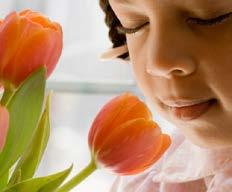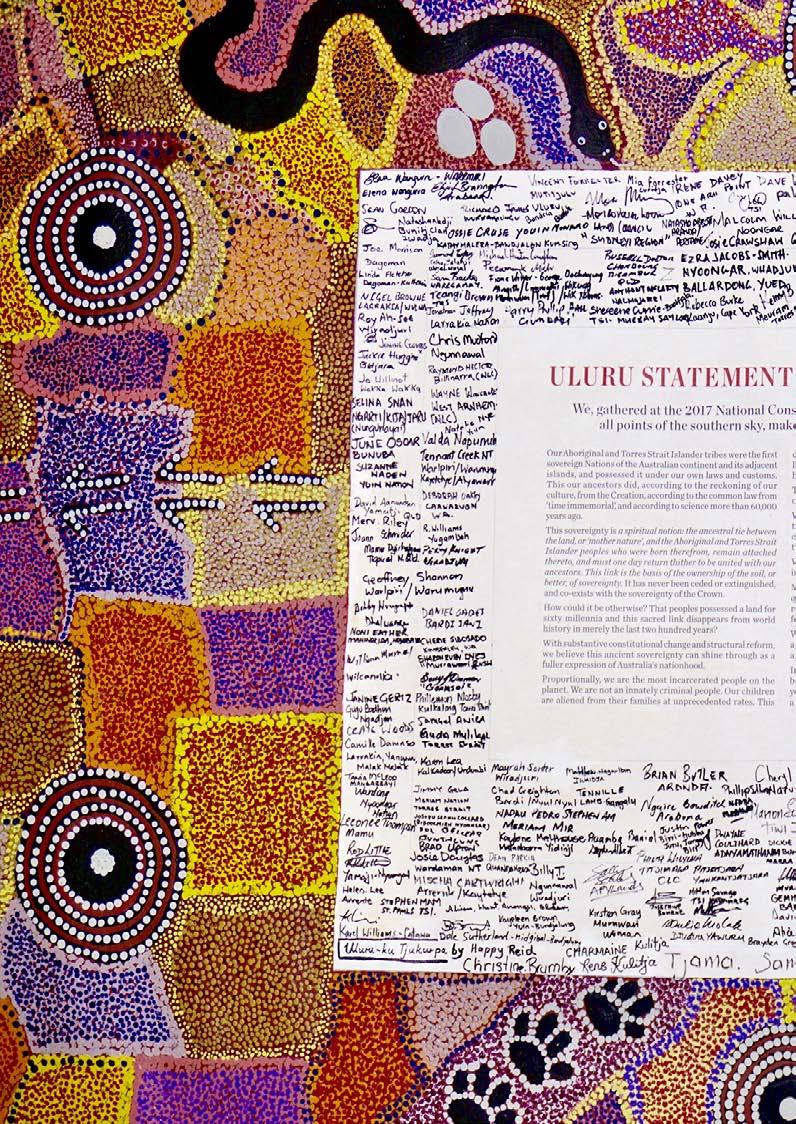
16 minute read
Five Ways to Create Self-Care During Self-Isolation
Kit Kline
As we spend more and more time alone, or in When stressful events such as Covid-19 varying levels of lockdown, the importance create another layer of tension, we may of creating wellbeing by having a tend to ruminate and overthink things. sensory connection to ourselves has never been higher. We can employ our five senses as a way to By incorporating Nature Based Therapy and our inherent Developing awareness of the body, an exercise in mindfulness, connect to our body and connection to nature, we are supported to get out of our head is paramount to grounding and the natural world within us and into our body. switching on our parasympathetic nervous system. and around us. We can do that by employing our five senses as a way to connect to our Often when we are feeling stressed we body and the natural world within us remain in a state of flight or flight, which in and around us. turn, keeps our cortisol levels on high alert.
Advertisement
Practical Ways to Bring the Outside In

TASTE
When looking at the natural world within us, it’s important to consider what food we choose to put into our bodies. What we eat plays a major part in helping us to restore balance within our digestive system. Our body is an ecosystem. More than 90 per cent of the body’s serotonin is synthesized in the gut. In fact, our gut is often described as our second brain. Read more about it here: https://www.ncbi.nlm.nih.gov/pmc/articles/PMC4393509/” Soups, stews and warm, slow cooked hearty meals that retain nutrients are perfect for this time. Think: this welcoming winter soup that ticks a lot of the boxes. https://www.sbs.com.au/food/recipes/lamb-shank-vegetable-and-barley-broth Even though you may be working from home, stopping to make a family meal or even just for yourself can take time away from your desk. Setting yourself up to succeed can start by using a few minutes in your morning to create a meal to simmer away in your slow cooker, ready for the end of the day.




SOUND Bringing in nature sounds or water features in the home can be another way to improve our connection, while supporting us to ground via our five senses. Inside your home, or within an an outdoor living space in your back yard, the sound of nature can be extremely soothing to the central nervous system. When you listen to a river flowing, there is something very relaxing and grounding about running water. I think it reminds us that nature is in a continual flow and that we need to keep moving with the flow regardless of what’s going on in our lives.
TOUCH Tending to indoor plants is a great way to bring nature into your environment. There are many plants that will love your company and will provide beautiful greenery to your work and living space. I have a Peace Lilly at home. When i forget to water it, it goes a bit limp. This to me is a reminder to take care of not just my plant but myself as well. I am prompted to ask myself: How well have I been hydrating? What do I need to do to take care of myself in this moment?
SCENT Opening up windows and doors every morning, even though it can get chilly in some areas, is still a worthwhile way to start the day in a mindful and body centred way. Fresh air and inviting the scent of our natural environment in can have a calming and emerging effect. A vaporiser or oil burner for essential oils can be beneficial for cleansing the air. Scents like lavender can have a relaxing effect, rosemary has a pick me up effect as well as an ability to enhance memory.
SIGHT Sight gives us the ability to view relaxing colours and images that put our body in a rest and digest state. Evoking a memory of a time when we felt connected and grounded in the sight of nature such as the ocean, a mountain, or a field, has the ability to reconnect us to what we perceive as beautiful and relaxing. What I like to recommend, especially during self-isolation, is for people to take themselves back to a space or place they felt connected to in nature. A photo from your most recent happy holiday of an experience you had in nature can take you back to that happy place and make you feel relaxed and grounded all over again.


Time to heal: Uluru healing the people and the land

Thomas Mayor
This entire continent, now called Australia, was once a First Nations have made a new beginning possible Dreaming. A place where flora, fauna, humankind and the land itself, together, determined the values and laws of First Nations society. We had no need for printed tomes, because our Dreaming, far older than any European text, was handed down in oral traditions from generation to The Uluru Statement from the Heart is a gift to the Australian people. I don’t say that to be poetic or to pull heartstrings. I say it because it is, practically, the gift of opportunity. generation, from custodian to custodian, in stories and Presented in the centre of a canvas that is 1.8 metres wide song as far back as the Ice Age. and 1.6 metres high, the Uluru Statement is a magnificent What a dream life was for my ancestors on this great southern continent. We were the most peaceful societies on the planet. All things had a place and moiety, and therefore all things were related. Our laws maintained balance and resolved disputes; no living being was incarcerated; our culture was one of sharing and respect. How else, experts agree, could hundreds of unique languages evolve for hundreds of First Nations in one common land, over 60,000 years? sacred object imbued with political and cultural power. Surrounding the words is a painting of four Anangu Songlines tracking from the north, east, south and west to intersect in the middle where the statement is printed and Uluru, the rock, would be. The painting is by Anangu law women Rene Kulitja, Charmaine Kulitja, Christine Brumby and Happy Reid, and their names are inscribed between the artwork and statement along with the names of the 250 First Nations people who endorsed it on 26 May 2017 at the Uluru National Constitutional ... the Uluru Statement is a magnificent sacred object Australia has much to learn from Aboriginal and Torres Strait Islander imbued with political and Convention. The creation of this gift was so profound and of such great ways, and thanks to my peoples’ cultural power. national significance that it must be resilience and resistance, Indigenous understood. custodianship survives to this day. Aboriginal and Torres Strait Islander knowledge is what Australia needs to awaken us from our colonial nightmare— to cease our growing cruelty to the vulnerable, to redistribute hoarded wealth, and to end the selfdestructive neglect of Mother Earth. At the Uluru National Constitutional Convention, the participants had come from all points of the southern sky. We were there representing the accurate records of thirteen regional dialogues who elected us. Like any large political gathering working towards a collective resolution, we had passionate debates and tense negotiations. Of But to be worthy of Indigenous knowledge—in fact, to course we did—we were talking about changing the exercise Indigenous knowledge—Australia must first rulebook of the nation, the Constitution, no less. accept Aboriginal and Torres Strait Islander sovereignty and hear our collective voice in the centre of decisionmaking. First Nations people have decided how we should do this: we have called for the establishment of a First Nations Voice enshrined in the Constitution—a guaranteed representative body—and invited you to walk with us in the Uluru Statement from the Heart. The three-day convention was emotionally draining. Not just because we felt the weight of responsibility to our people, but also because of the stinging attacks from our detractors. Some predicted we would descend into a screaming mess, assuming that that many Blackfellas could never come to an agreement. Others had a strange expectation for Indigenous homogeneity, believing that if there were a few Black dissenters or disgruntled mob who were not invited or able to attend a dialogue, somehow the controversy would make a resolution

unsupportable—an expectation that dehumanises and read the Uluru Statement from the Heart for the very first damages our cause. time. With a calm, steady voice, standing between massive We persevered, however, because we knew there was too much at stake—the status quo is killing us. We didn’t Indigenous flags at each end of the wide convention hall, she read: have the luxury of making vain, unachievable claims to The Uluru Statement from the Heart placate extreme ideologies. And we couldn’t walk away refusing compromise among ourselves, leaving the next generation the same difficult task. It was time, our time, to decide how to make permanent progress. The We, gathered at the 2017 National Constitutional Convention, coming from all points of the southern sky, make this statement from the heart: Uluru National Constitutional Convention, the Elders Our Aboriginal and Torres Strait Islander tribes were the expressed, was a once-in-a-lifetime opportunity for an first sovereign Nations of the Australian continent and unprecedented, and therefore powerful, Indigenous its adjacent islands and possessed it under our own laws political consensus worth campaigning for. and customs. This our ancestors did, according to In First Nations politics, there has never been a consensus position reached through a national deliberative process on how to achieve the reckoning of our culture, from the Creation, according to the common law from ‘time immemorial’, and according to science more than 60,000 years ago. Indigenous goals such as strong land rights, selfdetermination, It was time, our time, This sovereignty is a spiritual notion: the ancestral tie between the land, or treaty, constitutional recognition to decide how to make ‘mother nature’, and the Aboriginal and justice. These goals have all been promised to us by prime permanent progress. and Torres Strait Islander peoples who were born therefrom, remain attached ministers before— none has thereto, and must one day return thither been delivered. Before Uluru, as an to be united with our ancestors. This link activist on the streets, I realised the is the basis of the ownership of the soil, how was missing. It struck me that for or better, of sovereignty. It has never been five speakers on the stump, ten solutions ceded or extinguished, and co-exists with the would be proposed to the crowd. I noticed that sovereignty of the Crown. our actions were reactive and the politicians were never How could it be otherwise? That peoples possessed a land held to account. I listened to fellow Indigenous leaders, for sixty millennia and this sacred link disappears from and all too often, when asked what the steps to the grand world history in merely the last two hundred years?goals were, their answers were as vague as ‘unity’. I realised I was as vague as they were, and forced myself to ask: well, With substantive constitutional change and structural unity how? Tired of slogans without strategy at disjointed reform, we believe this ancient sovereignty can shine rallies that never held politicians accountable for their through as a fuller expression of Australia’s nationhood. broken promises and negligence, at Uluru I thought, this is Proportionally, we are the most incarcerated people on our chance. the planet. We are not an innately criminal people. Our By the final morning on 26 May 2017, we had patched children are aliened from their families at unprecedented together the tattered lessons from the past and developed rates. This cannot be because we have no love for them. a roadmap to a better future. With bated breath, we And our youth languish in detention in obscene numbers. watched Professor Megan Davis, an Aboriginal public law expert and one of the Indigenous members of the Referendum Council, as she stepped up to the podium to


They should be our hope for the future.
These dimensions of our crisis tell plainly the structural nature of our problem. This is the torment of our powerlessness. We seek constitutional reforms to empower our people and take a rightful place in our own country. When we have power over our destiny our children will flourish. They will walk in two worlds and their culture will be a gift to their country. We call for the establishment of a First Nations Voice enshrined in the Constitution.
Makarrata is the culmination of our agenda: the coming together after a struggle. It captures our aspirations for a fair and truthful relationship with the people of Australia and a better future for our children based on justice and selfdetermination.

We seek a Makarrata Commission to supervise a process of agreementmaking between governments and First Nations and truth-telling about our history. In 1967 we were counted, in 2017 we seek to be heard. We leave base camp and start our trek across this vast country. We invite you to walk with us in a movement of the Australian people for a better future.
When Professor Davis finished reading these words, the entire room—250 Aboriginal and Torres Strait Islander people with as many different First Nations and perspectives—stood as one and endorsed the Uluru Statement from the Heart with raucous acclamation. Not one person remained seated. I saw people who had been in passionate debate against one another embracing while crying tears of joy and hope. The endorsement of the Uluru Statement was an unforgettably moving moment, and not just for ourselves as Indigenous peoples. We believed it was a moving moment for all Australians—a constitutional moment. As Laureate Professor Emeritus Cheryl Saunders AO described when I joined her and several other constitutional experts on a panel at the Melbourne University Law School ten months later:
[Uluru was] a constitutional moment: a point in time at which people rise above their day-to-day preoccupations with a sense of collective purpose; to reach a sufficient consensus so as to make a new beginning possible. These moments are rare, and they need to be seized.
A Constitution frozen in time If constitutional moments are rare—and indeed, the Australian Constitution is said to be frozen in time—from what
We seek constitutional time do our ‘fundamental principles’ reforms to empower our that govern us come from? The answer doesn’t bode well for any of people and take a rightful us fair-minded Australian people, place in our own country. especially those of us who are Indigenous. The Australian Constitution was conceived from 100 years of genocide and slavery without remorse. In the late nineteenth century, on the bloody bed made for its birth, white British colonial men reached sufficient consensus on how to deliver the federalisation of a colonial nightmare. This was the first constitutional moment. Not one wretched Black soul was in the room— forsaken as a dying race. In 1901, the British subjects who became Australian voted to replace First Nations Dreaming with a bland, mechanical Constitution. In the first forty years of the new federation, Australian massacres of Indigenous people continued. And beyond the first forty years, the overt and covert acts of wilful neglect and slavery were maintained into the modern age. The Australian Constitution was not challenged by these heinous acts. Australian democracy did not hold the perpetrators to account. In these difficult circumstances, my Indigenous activist forebears campaigned to be counted as equal citizens

and to be included in the federal government’s ‘race power’, section 51(xxvi). The hope was that the federal government would use the race power to wrest control of Indigenous affairs from the cruel and negligent states. They succeeded in the 1967 referendum. More than 90 per cent of Australians, including Aboriginal and Torres Strait Islander voters, said ‘Yes’, we should be counted.
The result created the type of lasting change that only constitutional reform can provide—different from mere acts of parliament. In many ways, 1967 is the platform that my generation stands on. But painfully for my Elders, their allies and the following generations, the federal parliament broke the promise to use their acquired power to take control of Indigenous peoples from the states. When the federal government finally did—beginning with Gough Whitlam’s short reign that was ended by a constitutional crisis— they were rarely genuine or consistent, and too often worse than the states.

Both state and federal governments have since bungled Indigenous policy, squandered benevolent opportunity, and continued to oppress Indigenous empowerment. The 1967 constitutional moment, while important, fell terribly short of its mark. In 1901 we were excluded, in 1967 we were counted but not yet heard, and therefore, as a mere 3 per cent of the population, First Nations people remain unrepresented in the cold Canberra halls of democracy. With indifference, the government wields its power to make special laws for us as a ‘race’. Australia is trapped in its past; it’s time for constitutional change.
We must accept that the Dreaming constitutes us
Australia can only reckon with its past when we have changed the constitutional structure that excludes First Nations people. We will only heal when we have power over our own destiny. This is why the Uluru Statement prioritises the proposal to constitutionally enshrine a First Nations Voice—to centre Indigenous knowledge in decision-making and to build our political power so we may hold parliament to account. Enshrining a First Nations Voice is prioritised over agreementmaking and truth-telling—partly because both are underway and partly because these proposals can be done at the state level and by acts of parliament, but mainly because both treaty and truth need a voice to effect them.
Aboriginal and Torres Strait Islander people have done the hard work. We have learned from the past, strategised, prioritised and poured our hearts and our souls into a consensus providing Australia with a rare opportunity. We are leading the way in the Uluru Statement campaign, refusing to take no for an answer from politicians, fighting for a referendum so the people can decide if they will accept the gift we offer them. From all indications, the Australian people will say ‘Yes’. As we consider ideas about how to address the twin crises of climate change and growing inequality, and as we plan the steps we must take to reconstruct our humanity and democracy, imagine how much better we would be with a constitutionally empowered First Nations Voice at the table. When First Nations have a place at the table, we bring the voice of the land, the rivers, the sea, the flora and fauna.
When First Nations have a place at the table, we bring our principles of sharing, collectivism and respect. If we believe that Australia should keep dreaming, we must accept that the Dreaming constitutes us.











